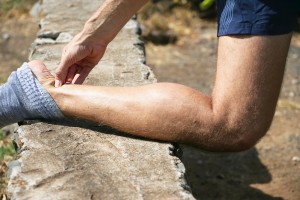Lower Limb Tendinopathy is a common problem across a broad age range and a major cause of frustration and pain.
Tendinopathy presents in the lower leg in the Achilles tendon and the Posterior Tibial Tendon. The Plantar Fascia is not strictly a tendon but it can behave much like a chronic tendon injury.
Tendinopathy can be a painful, time consuming and ongoing problem that can limit exercise and work. In the past tendinopathy has been poorly understood by health professionals. This has resulted in several incorrect treatment modalities and management strategies being implemented. The most common misconception is that chronic tendinopathy is an inflammatory issue. Although there may be some inflammatory cells present in a chronically injured tendon, the current research indicates this is not the primary source of pain and loss of function (more on this later).
The thought that inflammation is present is why you may have heard terms like Achilles Tendonitis and Plantar Fasciitis. Terminology describing something with “itis” implies inflammation. So historically, a lot of the failed treatments have focused at treating inflammation as a source. This may include complete rest, icing, ultrasound treatment, frictional massage, stretching and anti-inflammatory medications.
So, if inflammation isn’t the source of pain, what is going on?
Tendinopathy can be defined as a condition where overuse and excessive loading causes extensive changes to tendon cells and breakdown of collagen fibres within the tendon. The change in structure of the tendon creates an environment where water molecules are attracted to the tendon. This causes swelling – usually without inflammatory cells. In a chronically overloaded tendon, this can lead to permanent tendon damage and a degenerative tendon can result.
Factors such as a recent change in activity level – both increase and/or decrease in activity, poor biomechanics, footwear, age, medications, medical and injury history can contribute to an increased risk of tendon injury.
We can see the difference between a normal Achilles tendon (Left) and an Achilles with tendinopathy (Right). The normal one shows well-defined margins and a tight bundle of longitudinal collagen fibres. The tendinopathy image shows the fibres arranged more loosely than a healthy tendon and with visible swelling as water molecules enter the spaces available to them. This arrangement is not as structurally sound compared to a healthy tendon and less likely to handle the demands placed upon it.
Normal Achilles tendon
Tendinopathy within Achilles tendon
There are three stages of tendinopathy, where a continuum can exist between each stage:
Stage One: Reactive tendinopathy
- increased non-inflammatory swelling and pain following a period of acute overload – “too much, too soon”.
- The tendon has little structural change, and swelling is reversible if overload is reduced.
- Usually occurs in young athletes.
- Can be painful and slow to settle.
Stage Two: Tendon disrepair
- Longer term damage to a tendon causing the beginnings of tendon cell breakdown.
- Seen as a chronically overloaded tendon with diffuse swelling.
- Somewhat reversible, particularly in younger patients, older patients less likely.
Stage Three: Degenerative tendinopathy
- Tendon fibres become disordered, and cell death occurs, causing irreversible tendon damage.
- Rarely leads to rupture/tearing in the tendon.
- Typically seen in older patients where there has been sustained load for a long period of time.
So what do we do for your tendinopathy?
The aim of your rehabilitation program is to remove the water molecules (swelling) and strengthen the remaining healthy tendon to return you to normal function. What this exactly entails depends on the nature of your injury, combined with many individual contributing factors.
Each stage of tendinopathy requires different treatment principals and individual factors be considered when devising a rehabilitation plan. Having a tailored rehab plan is vital in returning to activity as quickly as possible and can only be provided following a thorough lower limb physical assessment.
In the early stages of tendinopathy, the basic treatment principals focus on reducing high load activities to manageable level.s Once certain milestones have been met we work on rebuilding functional strength to the injured area to avoid re injury. If not done well, early stage tendinopathy can become quite a time consuming and painful injury and progress to a degenerative tendon.
In later stages of tendinopathy, it is unlikely the tendon will return to ‘normal’ structure. However research shows this is not required to return to normal function. Treatment focuses on strengthening the good, healthy tendon fibres that are surrounding the damaged fibres.
Summary
No matter the type of tendinopathy, all contributing factors such as activity modifications, bio mechanical and footwear considerations will be addressed as a part of your rehabilitation program. These are not limited to, but may include, orthotic therapy, footwear changes and changes to your day to day activities.
As you may have gathered, tendinopathy is a complex and multi-factorial issue that requires careful, individualized management over a period of time. My colleagues and I can help you with accurate diagnosis and the creation of a personalized rehabilitation strategy for your painful tendon.
Feel free to book a consultation on the BOOK NOW button above or call the clinic on 9890 2212 for a full assessment.
Cheers,
Kyle Dalmau
Podiatrist


